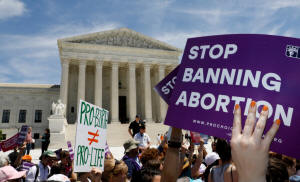Explainer: Supreme Court's Roe v. Wade decision hinged on women's right
to privacy
 Send a link to a friend
Send a link to a friend
 [September 23, 2020]
WASHINGTON (Reuters) - The death of
U.S. Supreme Court Justice Ruth Bader Ginsburg has raised concerns among
reproductive rights advocates that women could lose the right to choose
whether to have an abortion, with President Donald Trump poised to name
another conservative justice to the nation's top court. [September 23, 2020]
WASHINGTON (Reuters) - The death of
U.S. Supreme Court Justice Ruth Bader Ginsburg has raised concerns among
reproductive rights advocates that women could lose the right to choose
whether to have an abortion, with President Donald Trump poised to name
another conservative justice to the nation's top court.
A woman's right to have an abortion through the first trimester of
pregnancy was protected nationally in 1973, following the Supreme
Court's landmark 7-2 ruling in Roe v. Wade.
Plaintiff Jane Roe, later identified as Norma McCorvey, was an unmarried
pregnant woman who was unable to get an abortion under Texas law, where
it was illegal unless to save the life of the mother.
Roe's lawyers said she was unable to travel out of the state to obtain
an abortion and argued that the law was too vague and infringed on her
constitutional rights.

THE MAJORITY RULING
"Pregnancy often comes more than once to the same woman, and in the
general population, if man is to survive, it will always be with us,"
Supreme Court Justice Harry Blackmun, a Republican nominated by
President Richard Nixon, wrote in the sweeping majority opinion that
detailed attitudes about abortion from the time of the Persian empire.
The Texas law infringed on women's right to privacy, was overly broad
and violated the due process clause in the U.S. Constitution's
Fourteenth Amendment https://www.ourdocuments.gov/doc.php?flash=false&doc=43,
the decision said.
"This right of privacy...is broad enough to encompass a woman's decision
whether or not to terminate her pregnancy. The detriment that the State
would impose upon the pregnant woman by denying this choice altogether
is apparent.
"Specific and direct harm medically diagnosable even in early pregnancy
may be involved. Maternity, or additional offspring, may force upon the
woman a distressful life and future. Psychological harm may be imminent.
Mental and physical health may be taxed by child care. There is also the
distress, for all concerned, associated with the unwanted child, and
there is the problem of bringing a child into a family already unable,
psychologically and otherwise, to care for it.
[to top of second column]
|

Abortion rights activists rally outside the U.S. Supreme Court in
Washington, U.S., May 21, 2019. REUTERS/Kevin Lamarque

"In other cases, as in this one, the additional difficulties and
continuing stigma of unwed motherhood may be involved. All these are
factors the woman and her responsible physician necessarily will
consider in consultation."
Five Republican-nominated judges were among the majority. The court
ruled the state could regulate the procedure during the second
trimester and even ban it in most circumstances in the third.
"We do not agree that, by adopting one theory of life, Texas may
override the rights of the pregnant woman that are at stake,"
Blackmun wrote.
"We repeat, however, that the State does have an important and
legitimate interest in preserving and protecting the health of the
pregnant woman, whether she be a resident of the State or a
nonresident who seeks medical consultation and treatment there, and
that it has still another important and legitimate interest in
protecting the potentiality of human life. These interests are
separate and distinct."
Justices Byron White, a Democratic appointee, and
Republican-nominated William Rehnquist, later U.S. chief justice,
dissented. The decision provoked a firestorm among social and
judicial conservatives, who have long sought to undermine or
overturn it.
(Reporting by Makini Brice; Editing by Peter Cooney)
[© 2020 Thomson Reuters. All rights
reserved.] Copyright 2020 Reuters. All rights reserved. This material may not be published,
broadcast, rewritten or redistributed.
Thompson Reuters is solely responsible for this content.
 |